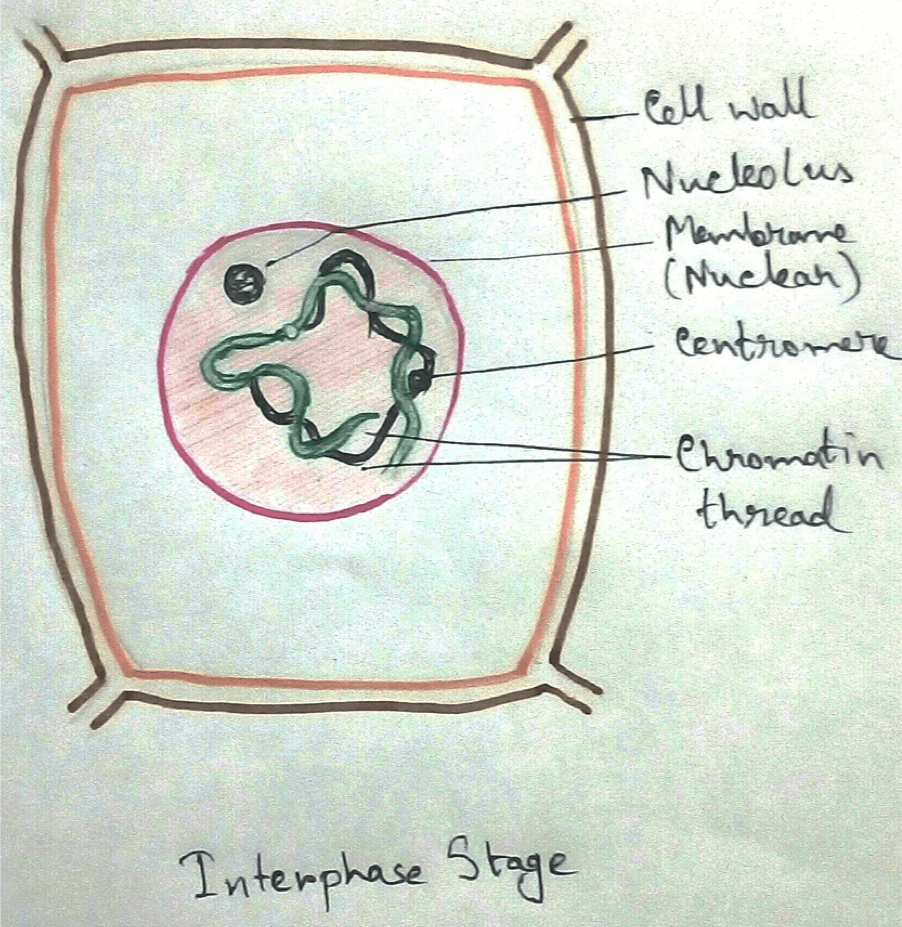Explain about Interphase
Definition of interphase- Interphase is a stage between two mitotic cycles in an eukaryotic cell, during which various physical and chemical changes for the preparation of cell division takes place.
Interphase of cell division is the longest period of cell division and is called inter-mitotic phase. The chromosomes appear as long and thin forms diffused chromatin net. It is not properly visible due to highly hydrated conditions.
Subdivisions of Interphase - In 1953 Howard and Pele divided interphase into 3 subtypes.
1. Post mitotic Gap phase - It is also called G1 phase. This phase occupies 30- 50% of the cell cycle .As it is the early stage of interphase and is called first growth phase. This phases are followed by –
* In this phase RNA and various regulatory proteins are synthesized.
* Enzymes those are required for DNA synthesis like DNA polymerase are synthesized.
* No DNA synthesis take place.
* Tubule is accumulated which causes elongation of the nucleus.
2. Synthetic phase (S-Phase) - It occupies 35 to 45% of the cell cycle. It is
called the mid interphase stage in which all the major metabolic activities of
dividing cell takes place.
The characteristics of stages are-
* DNA is synthesized in this phase.
* Volume of the nucleus becomes double when DNA is replicated.
* Here histone proteins are synthesized.
* Single chromatid of the chromosome gets duplicated to form two identical chromatids.
3. Pre-mitotic gap phase (G2 phase) - It constitutes 10 to 20% of cell cycle and also referred to as the second growth phase and actually is the gap between S phase and prophase .
Special characteristics of the interphase-
* Synthesis of specific RNA and protein.
* Stopping of DNA synthesis.
Major Characteristics of the Interphase
The major characteristics of interphase are:
1. The replication of chromatids and DNA .As a result the single chromatid (monad) becomes double (dyad).
2. Nuclear membrane remains intact and distinct.
3. Nucleolus enlarges due to accumulation of RNA and ribosomal protein in this stage.
4. Synthesis of energy rich ATP molecules and microtubules take place, that act as precursor of spindle fibres.
5. In general, the cells are increase in size due to accumulation of cytoplasm.
6. In case of animal cell , a new centrosome formed from the existing one with pair of centrioles which placed at right angles to each other. Means there are two pairs of centrioles in the cell.
7. In interphase the thin and elongated chromatin threads of the chromatin network appear diffused and less divisible due to highly hydrated conditions.
8. The net membrane biosynthesis increases and it remains stored at the cell surface in the form of blebs which help the cell to divide on animal cells.
Questions and Answers on Interphase:
1. What do you mean by G0 phase?
In terminally differentiated somatic cells like neurone and muscle cells which cannot be divided. This arrested phase of G1 is known as G0 phase.
2. When is interphase observed?
The period of interval which is observed between the two cell divisions is called interphase.
From Explain about Interphase to HOME PAGE
Recent Articles
-
Explain about Growth in Plants |Definition of Growth & Differentiation
Feb 27, 25 02:07 PM
Growth is a permanent increase in length or volume of an organism that brought upon by an increase in its dimensions due to synthesis of new protoplasmic material. -
Definition of Respiratory Quotient | calculation | Application | Plant
Dec 02, 24 12:09 AM
Definition of respiration quotient- the ratio of the carbon-dioxide evolved to that of the oxygen consumed by a cell, tissue, plants or animals in a given time is called respiratory quotient. It is us… -
Amphibolic Pathway | Definition | Examples | Pentose Phosphate Pathway
Jun 06, 24 10:40 AM
Definition of amphibolic pathway- Amphibolic pathway is a biochemical pathway where anabolism and catabolism are both combined together. Examples of amphibolic pathway- there are different biochemical… -
Respiratory Balance Sheet | TCA Cycle | ATP Consumption Process
Feb 18, 24 01:56 PM
The major component that produced during the photosynthesis is Glucose which is further metabolised by the different metabolic pathways like glycolysis, Krebs cycle, TCA cycle and produces energy whic… -
Electron Transport System and Oxidative Phosphorylation | ETC |Diagram
Feb 04, 24 01:57 PM
It is also called ETC. Electron transfer means the process where one electron relocates from one atom to the other atom. Definition of electron transport chain - The biological process where a chains…





New! Comments
Have your say about what you just read! Leave me a comment in the box below.